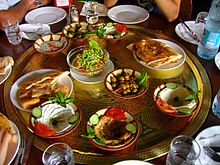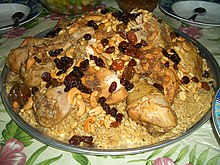Arabic cuisine

As Arab cuisine is called the cuisines of the Arabian Peninsula belonging countries as well as the cuisine of the region Middle East, as the Middle East and in some cases as Orient is called. Their influence can also be seen in North African cuisine in the Maghreb . The term oriental cuisine , which is often used in cookbooks , usually also means Persian cuisine , Kurdish cuisine and Turkish cuisine , each of which has its own culinary tradition.
General
Although the regional cuisines of the Middle East are quite different, there are numerous similarities that characterize the Arabic cuisine . The staple foods include legumes such as lentils and beans , which are often made into pastes and used in many ways in the kitchen. A well-known bean soup in the Maghreb is called baisar . Falafel are fried dumplings made from pureed beans or chickpeas . Milk is rarely drunk straight - a large part of the population of the Arab region is lactose intolerant - but mostly processed into yoghurt or kaymak , sometimes also into ghee and cheese .
Lamb - either prepared or boiled as a kebab - is the most commonly eaten type of meat in the Arab world. All parts of the lamb are used including the innards , head and feet. For the dish khouzi , a whole lamb is baked, stuffed with chicken, eggs and rice and seasoned with saffron and onions and served whole on a bed of rice.
Chickens are popular foods, and in Egypt and North Africa occasionally pigeons . Pork is taboo in Islam and is not consumed by Muslims and is seldom consumed by Christians in the region either. Fish plays an important role in the coastal regions . Meat dishes are often given a sour taste by adding lemon juice, yogurt, vinegar , tamarind , pomegranate juice or sumac . Baharat , a mixture of spices, is often used in meat dishes.
Most vegetables are cooked with meat. In pure vegetable dishes, the vegetables are often filled with rice. Vegetables pickled in vinegar also play a role as a side dish . Fresh or dried fruits are often used in cooked dishes, often as an accompaniment to meat.
Wheat is considered to be the most important grain in the region, although rice also plays a major role in some countries. Couscous originally comes from North Africa and from there spread to Syria , where bulgur is mainly used.
Bread is sometimes baked as paper-thin flatbread called chubz, which is often topped with boiled meat and eaten rolled up. Such a dish called Tharid is said to have been the favorite dish of the Prophet Mohammed . Every country knows variants of it. In Yemen , a filling made from meat, runny egg, honey and melted butter is called fatut .
In the course of its development since the time of the caliphs, Arabic cuisine took over some elements of Persian cuisine, which is also reflected in the borrowing of numerous Persian kitchen terms. As in Iran 's pickled sour vegetables turshi , soup shurba or chorba , meatballs hot kufta ( kofte ) and appetizers Mezze .
As a popular Arabic dessert applies Muhallabia , a sweet rice pudding. Pastries filled with dates such as ma'amoul were widespread . Baklava is known from Turkish cuisine , but it is also of Syrian or Greek origin. Many desserts are sweetened with dibs , a syrup made from dates, and honey .
Coffee is the most commonly consumed drink in the region, often flavored with cardamom . In second place in the east ( Maschrek ) is mostly black and heavily sweetened tea , in the west, the countries of the Maghreb, green tea with peppermint. Karkadeh is drunk hot or cold in Egypt and Sudan.
Bedouin
The Bedouins who live as nomads in Arab countries have developed their own food culture . The camels , the most important economic possession, are slaughtered at best when old or sick, as are surplus young stallions. Near oases keeping sheep and goats as milk and meat source.
The daily diet of the Bedouins traditionally consisted almost exclusively of milk from camels, goats or sheep, bread and dates. The thin bread was baked on a tray over an open fire. Other staple foods are wheat, rice and samn ( clarified butter). Small game caught were also cooked whole in an open fire. For special feasts, however, the meat was prepared in a large copper saucepan ( jidda ) and served with rice (in the form of kabsa ).
Salted yoghurt was used to prepare a jamid (cheese) dried in the sun , which - after a long drying period, dried as hard as a rock - had to be moistened with water or pounded in a mortar before eating . This hard cheese is very durable.
The Bedouins express the traditionally high value of hospitality through various rituals, which also include entertaining guests. Before the actual meal, guests are served coffee or buttermilk and dates. The main course in honor of the guest made of mutton or camel meat on a bed of rice, mansaf , is offered first to the guest, then to the men according to their rank, the leftovers are left for women and children.
literature
- Khalila Aziz et al. a .: The Arabic cuisine. Cookbook cookery dictionary . Verlag Diwan, Zurich 2005, ISBN 3-908547-15-6 (in German and Arabic script).
- Alan Eaton Davidson : Arab cuisine , Arabian food and Bedouin food . In: Ders .: The Oxford Companion to Food . 2nd ed. University Press, Oxford 2006, ISBN 978-0-19-280681-9 .
- Gisela Darrah, Heike Abd el Maksoud: Coffee with cardamom, stories and delights from the Orient . Books on Demand 2010, ISBN 978-3-8391-8622-0 .
- Florian Harms , Lutz Jäkel: Culinary Arabia . Neuer Umschau Buchverlag, 2011, ISBN 3-865287-27-1
